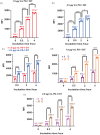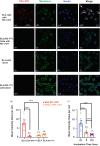Diphtheria toxin-derived, anti-PD-1 immunotoxin, a potent and practical tool to selectively deplete PD-1+ cells
- PMID: 37515422
- PMCID: PMC10443333
- DOI: 10.1002/pro.4741
Diphtheria toxin-derived, anti-PD-1 immunotoxin, a potent and practical tool to selectively deplete PD-1+ cells
Abstract
Programmed death-1 (PD-1), an immune checkpoint receptor, is expressed on activated lymphocytes, macrophages, and some types of tumor cells. While PD-1+ cells have been implicated in outcomes of cancer immunity, autoimmunity, and chronic infections, the exact roles of these cells in various physiological and pathological processes remain elusive. Molecules that target and deplete PD-1+ cells would be instrumental in defining the roles unambiguously. Previously, an immunotoxin has been generated for the depletion of PD-1+ cells though its usage is impeded by its low production yield. Thus, a more practical molecular tool is desired to deplete PD-1+ cells and to examine functions of these cells. We designed and generated a novel anti-PD1 diphtheria immunotoxin, termed PD-1 DIT, targeting PD-1+ cells. PD-1 DIT is comprised of two single chain variable fragments (scFv) derived from an anti-PD-1 antibody, coupled with the catalytic and translocation domains of the diphtheria toxin. PD-1 DIT was produced using a yeast expression system that has been engineered to efficiently produce protein toxins. The yield of PD-1 DIT reached 1-2 mg/L culture, which is 10 times higher than the previously reported immunotoxin. Flow cytometry and confocal microscopy analyses confirmed that PD-1 DIT specifically binds to and enters PD-1+ cells. The binding avidities between PD-1 DIT and two PD-1+ cell lines are approximately 25 nM. Moreover, PD-1 DIT demonstrated potent cytotoxicity toward PD-1+ cells, with a half maximal effective concentration (EC50 ) value of 1 nM. In vivo experiments further showed that PD-1 DIT effectively depleted PD-1+ cells and enabled mice inoculated with PD-1+ tumor cells to survive throughout the study. Our findings using PD-1 DIT revealed the critical role of pancreatic PD-1+ T cells in the development of type-1 diabetes (T1D). Additionally, we observed that PD-1 DIT treatment ameliorated relapsing-remitting experimental autoimmune encephalomyelitis (RR-EAE), a mouse model of relapsing-remitting multiple sclerosis (RR-MS). Lastly, we did not observe significant hepatotoxicity in mice treated with PD-1 DIT, which had been reported for other immunotoxins derived from the diphtheria toxin. With its remarkable selective and potent cytotoxicity toward PD-1+ cells, coupled with its high production yield, PD-1 DIT emerges as a powerful biotechnological tool for elucidating the physiological roles of PD-1+ cells. Furthermore, the potential of PD-1 DIT to be developed into a novel therapeutic agent becomes evident.
Keywords: PD-1; autoimmune diseases; cancer; diphtheria toxin-derived immunotoxin; programmed death-1 cells; protein therapeutics; yeast.
© 2023 The Protein Society.
Conflict of interest statement
The authors have declared that no competing interest exists.
Figures






Similar articles
-
Development of a diphtheria toxin based antiporcine CD3 recombinant immunotoxin.Bioconjug Chem. 2011 Oct 19;22(10):2014-20. doi: 10.1021/bc200230h. Epub 2011 Sep 9. Bioconjug Chem. 2011. PMID: 21866954 Free PMC article.
-
In Vivo Tumor Therapy with Novel Immunotoxin Containing Programmed Cell Death Protein-1 and Diphtheria Toxin.Monoclon Antib Immunodiagn Immunother. 2021 Jun;40(3):113-117. doi: 10.1089/mab.2020.0043. Epub 2021 Jun 1. Monoclon Antib Immunodiagn Immunother. 2021. PMID: 34076502
-
Genetic construction and characterization of an anti-monkey CD3 single-chain immunotoxin with a truncated diphtheria toxin.Bioconjug Chem. 1997 Sep-Oct;8(5):695-701. doi: 10.1021/bc9701398. Bioconjug Chem. 1997. PMID: 9327133
-
Treatment with immunotoxin.Philos Trans R Soc Lond B Biol Sci. 2001 May 29;356(1409):681-9. doi: 10.1098/rstb.2001.0839. Philos Trans R Soc Lond B Biol Sci. 2001. PMID: 11375071 Free PMC article. Review.
-
Mutations in diphtheria toxin to improve immunotoxin selectivity and understand toxin entry into cells.Semin Cell Biol. 1991 Feb;2(1):39-45. Semin Cell Biol. 1991. PMID: 1954342 Review.
Cited by
-
PD-1 Bispecific Killer Engager (PD-1 BiKE) effectively depletes effector T lymphocytes in experimental autoimmune encephalomyelitis.Front Immunol. 2025 Aug 13;16:1644903. doi: 10.3389/fimmu.2025.1644903. eCollection 2025. Front Immunol. 2025. PMID: 40881711 Free PMC article.
-
Development and Characterization of an Anti-PD-L1 Immunotoxin for Targeted Cancer Therapy.Curr Pharm Biotechnol. 2025;26(6):854-862. doi: 10.2174/0113892010321088240823062243. Curr Pharm Biotechnol. 2025. PMID: 39238385
-
Protein-Based Degraders: From Chemical Biology Tools to Neo-Therapeutics.Chem Rev. 2025 Feb 26;125(4):2120-2183. doi: 10.1021/acs.chemrev.4c00595. Epub 2025 Jan 17. Chem Rev. 2025. PMID: 39818743 Review.
-
Advances in immunotoxin engineering: precision therapeutic strategies in modern oncology.Med Oncol. 2024 Sep 4;41(10):239. doi: 10.1007/s12032-024-02478-3. Med Oncol. 2024. PMID: 39230639 Review.
-
Some Examples of Bacterial Toxins as Tools.Toxins (Basel). 2024 Apr 23;16(5):202. doi: 10.3390/toxins16050202. Toxins (Basel). 2024. PMID: 38787054 Free PMC article. Review.
References
-
- Arata Y, Watanabe A, Motosugi R, Murakami R, Goto T, Hori S, et al. Defective induction of the proteasome associated with T‐cell receptor signaling underlies T‐cell senescence. Genes Cells. 2019;24(12):801–813. - PubMed
-
- Arndt Br, Witkowski L, Ellwart J, Seissler J. CD8+ CD122+ PD‐1− effector cells promote the development of diabetes in NOD mice. J Leucocyte Biol. 2015;97(1):111–120. - PubMed
Publication types
MeSH terms
Substances
Grants and funding
LinkOut - more resources
Full Text Sources

